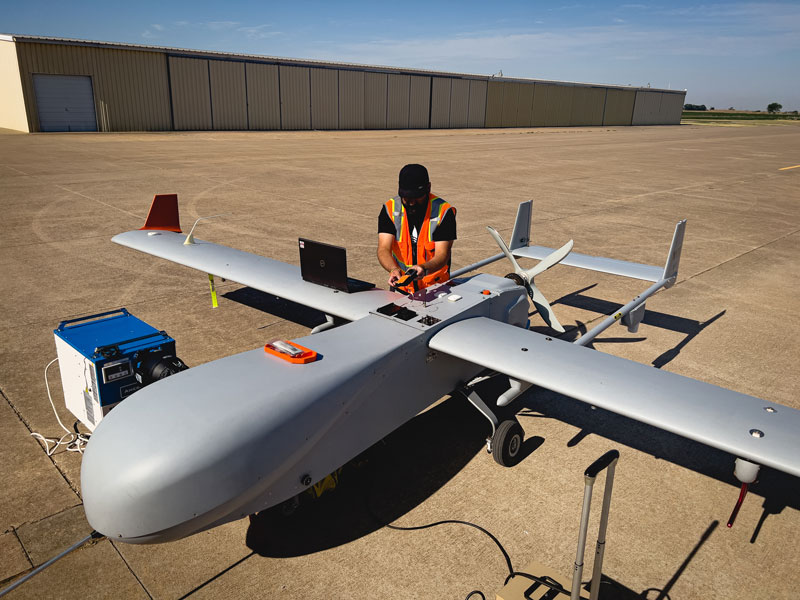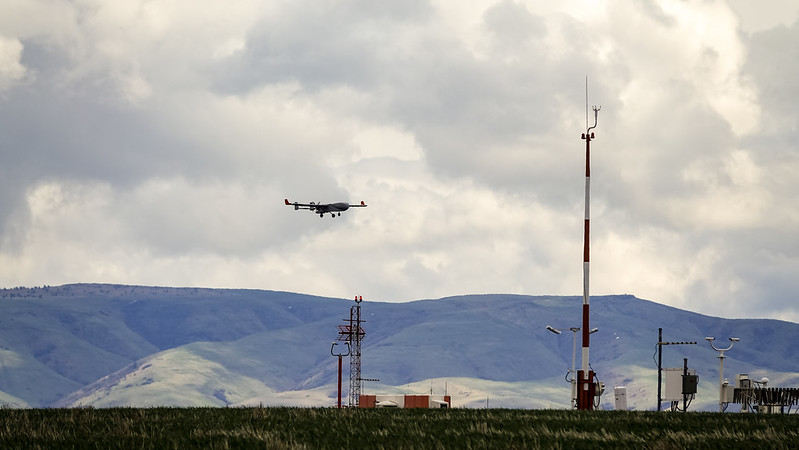ArcticShark and ARM Team Overcome the Oklahoma Heat
Published: 30 August 2022
Data from uncrewed aerial system flights now available for use

As summer temperatures soared in north-central Oklahoma, so too did the Atmospheric Radiation Measurement (ARM) Aerial Facility’s (AAF) ArcticShark uncrewed aerial system (UAS).
From July 6 to 18, 2022, the AAF conducted seven UAS flights above farms and ranches to the ARM user facility’s Southern Great Plains (SGP) atmospheric observatory. There, the UAS flew precise flight patterns between 2,000 and 4,000 feet, collecting atmospheric data before returning to the regional Blackwell-Tonkawa Municipal Airport.
“The entire flight series was a great success for the ArcticShark program,” reports Jason Tomlinson, who leads the AAF’s engineering efforts. “We are excited about the data we collected over the SGP; it was very high quality, and importantly, it was consistent with measurements taken from the ground.”
Collected data focus on aerosol and other basic meteorological measurements, such as surface temperature, relative humidity, multispectral imagery, and three-dimensional wind measurements.
These data are now available in ARM Data Discovery.
Really Good at Boring

Tomlinson compares a UAS to a computer: “Computers are really good at doing boring things, and that’s what they’re there for—repeating patterns over and over again. The computer doesn’t complain, doesn’t get tired; it just does it. Likewise, the ArcticShark is very good at flying long, very boring flight patterns that are very useful scientifically.”
Piloted remotely, the ArcticShark in Oklahoma followed a carefully planned flight path. Meanwhile, on the ground, staggered visual observers between the airport and the SGP tracked the UAS to ensure safe operations.
“Our visual observers out there performed extremely well,” says Tomlinson. “In the end, all of our planning came to fruition, and the flights functioned as they should—routinely—even in the extreme heat.”
The 110-degree-plus temperatures were even higher in the ArcticShark’s small payload bays for instruments. With little airflow, the AAF’s miniaturized atmospheric sensing instruments can experience the stress of temperatures higher than the surrounding environment.
“The high heat helped make this one of the tougher deployments we’ve ever had,” says Tomlinson. “But we adjusted by shifting operations to early morning hours and were able to get flights in safely. And our people, the ArcticShark, and the payload all performed well.”
Move to Regular UAS Operations

The July flights were another critical step to bring ARM’s UAS program to a more active status, says Tomlinson. “The trajectory is very good. We have built a good understanding of the ArcticShark’s operational parameters.”
The July campaign was a follow-up to a series of flights in November 2021, which were a proof-of-concept mission designed to evaluate the implementation of customized instrumentation and demonstrate safe operations. (Data from the November flights are available in Data Discovery.)
The most recent flights, says Tomlinson, were a great opportunity to “exercise” ARM’s UAS program and move it toward more regular operations.
Eventually, this may include user proposals. But at this time, ARM will use the ArcticShark for baseline, routine measurements at the SGP.
This fall, at the 2022 Joint ARM User Facility/Atmospheric System Research (ASR) Principal Investigators Meeting, there will be an AAF breakout session in which user feedback, comments, and suggestions regarding UAS will be solicited. The breakout session is scheduled for 2 to 4 p.m. Eastern time Tuesday, October 25.
“We want to hear how the ARM community wants to use UAS, what kind of measurements they want to take, and what flight patterns would benefit their research,” says Tomlinson. “By starting this conversation, we hope to meet the needs of the ARM community better.”
Looking ahead, the ArcticShark will be further tested this fall in Pendleton, Oregon, in low-elevation flights.
Keep up with the Atmospheric Observer
Updates on ARM news, events, and opportunities delivered to your inbox
ARM User Profile
ARM welcomes users from all institutions and nations. A free ARM user account is needed to access ARM data.


















